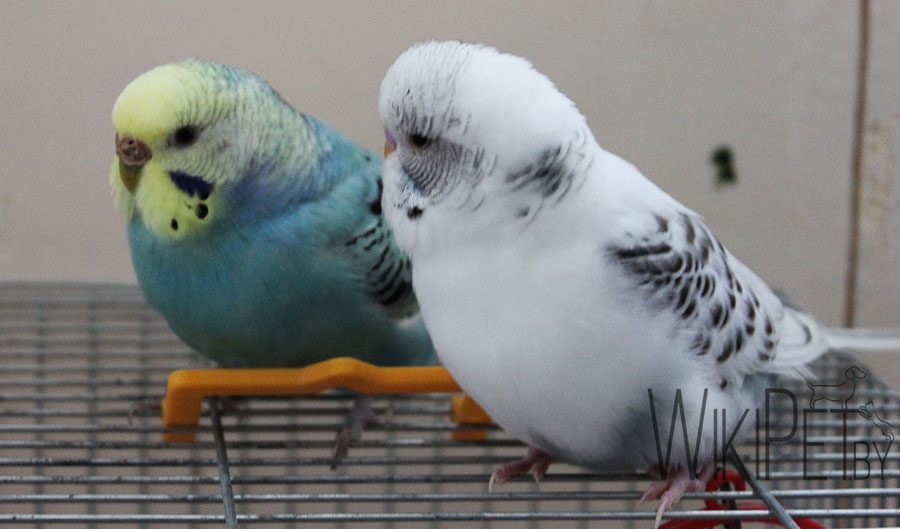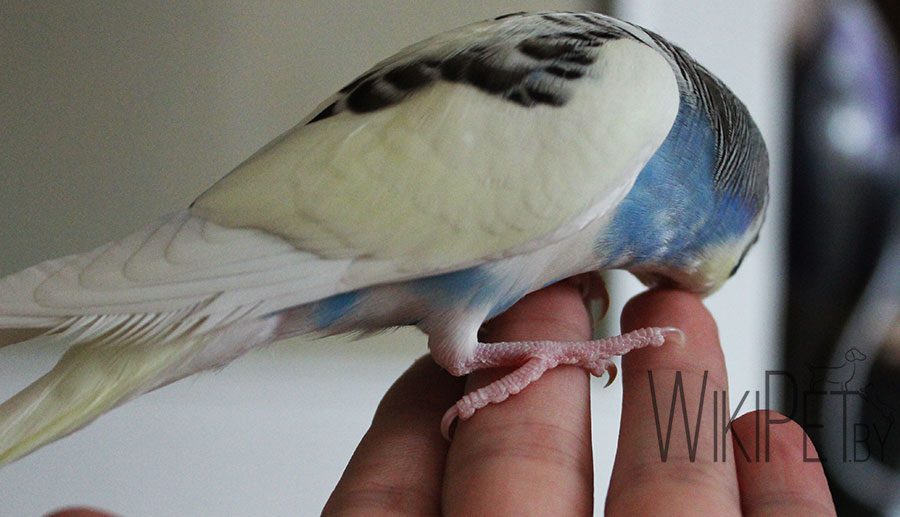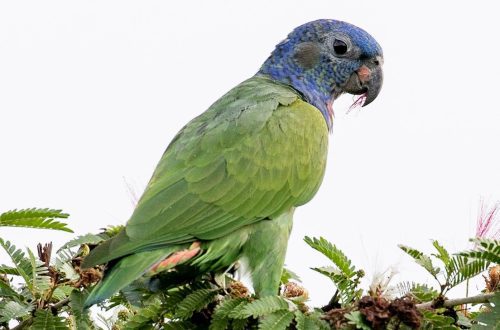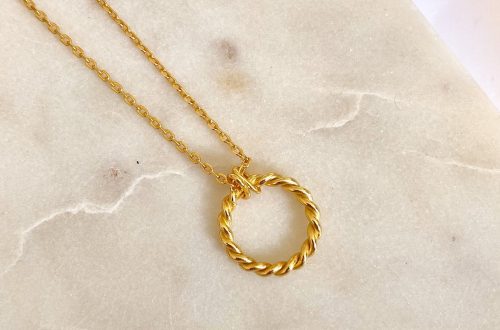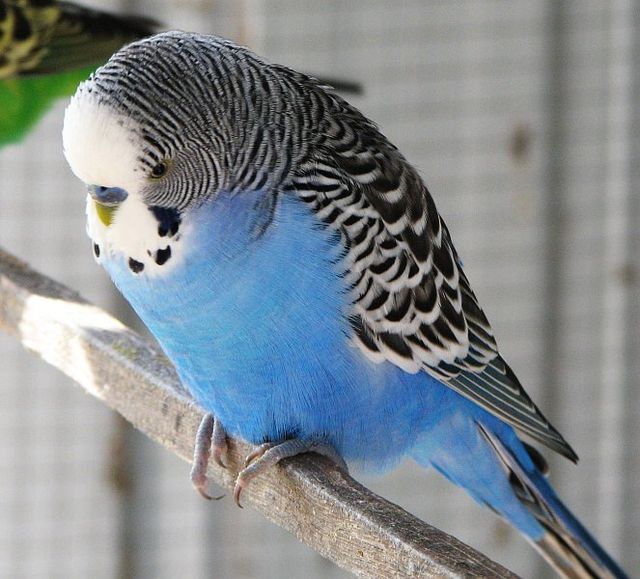
Budgie
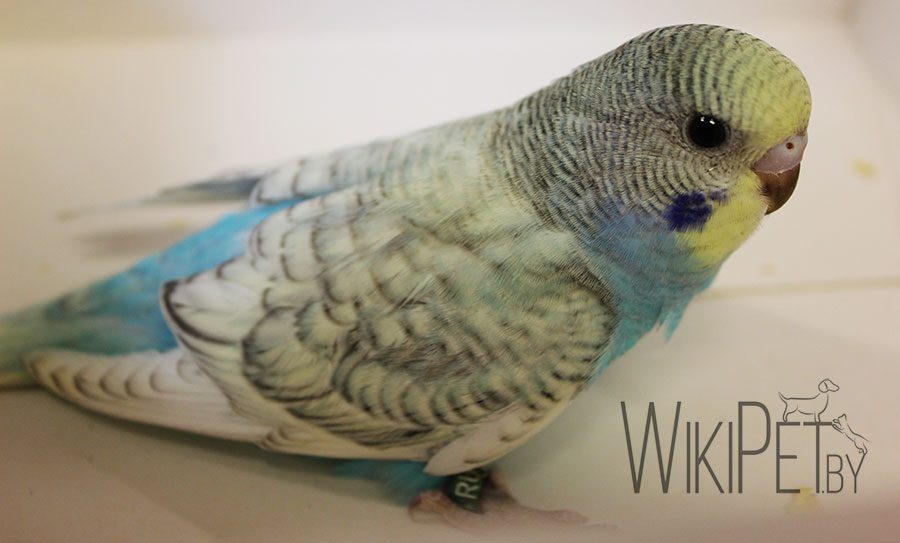
| Budgie | Melopsittacus undulatus |
| Order | Parrots |
| family | Parrots |
| Race | Wavy Parrots |
Contents
HABITAT AND LIFE IN NATURE
The name of the budgerigar is given for a reason. Melopsittacus undulatus is Latin for wavy-patterned songbird. And the English Budgerigar came from the Australian Betchegara, which means “good food”, as the Australian Aborigines eat these birds.
In nature, almost all birds are colored the same. The main color of their body is grassy green, in front of the head there is a mask of pale yellow color with 6 black throat spots. On each side of the head there is also one zygomatic spot of purple color. The upper part of the body, starting from the edge of the yellow mask and the neck, as well as the wings and back, are covered with a black wavy pattern. Paws are pale grey-green. The two long central feathers are dark blue with a metallic sheen. This coloration is protective and allows the budgerigars to blend in with the surrounding tree leaves and grasses. The body size of adult birds is only 18 – 19 cm.
Wild budgerigars inhabit the plains of Australia and constantly roam in search of food. Their swift flight resembles the flight of a falcon. They live in packs and take care of each other for a large amount of time. The size and composition of the flock change every minute, individuals leave and join it constantly. Most flocks contain between 10 and 100 birds, however these small flocks can form huge flocks, often consisting of thousands of birds.
In the historical homeland, the air temperature often fluctuates within 56 degrees, and fluctuations in the duration of daylight hours are 3,5 – 5 hours.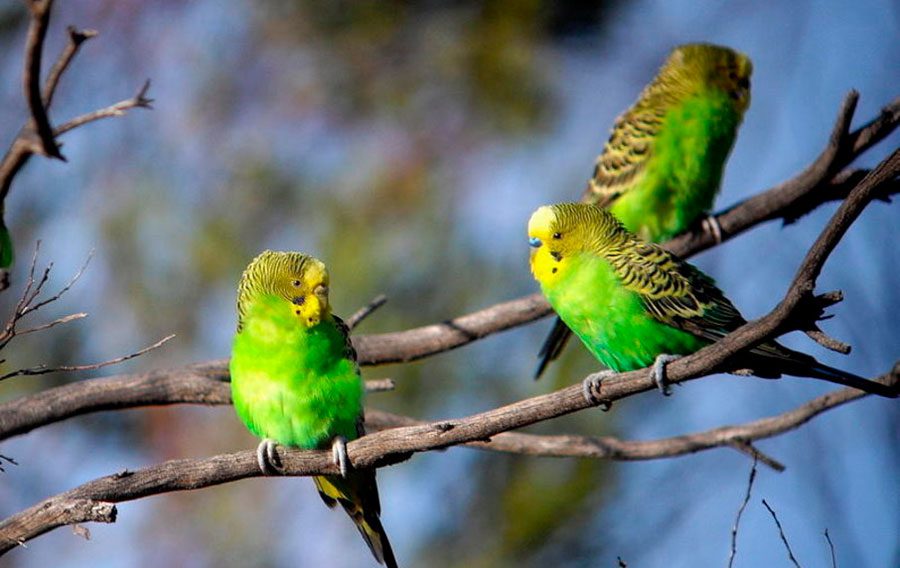
When the time comes to create a family (September – December), budgerigars break into pairs and build nests in hollow trees on the edges of acacia and eucalyptus forests. During the nesting period, males create their flock to jointly search for food for females that hatch eggs. Pairs from adjacent nesting sites gather in small flocks and feed together near the trees where their nests are located.
8 different sounds have been identified in wild budgerigars. The most frequent sound coming from a flock of birds in flight is very similar to the chirping of pet parrots. Other calls mean anxiety or conflict with other members of the pack, as well as during courtship. When feeding, chicks and hatching females also make peculiar sounds.
At different times, budgerigars have flown or been released by hosts in different countries, so it is not surprising that wild populations of these birds have emerged that have taken root from such accidental or deliberate occurrences in these places. An example of such a population exists in the USA, Florida. As a result of studies conducted in 1977, it was found that such populations are found mainly from the Golf Coast and Spring Hill, north of Naples, with small populations on the Atlantic coast from Fort Pierce, to Fort St. Lucy and Lauderdale. These birds are found in the suburbs, depending on the availability of food supply and nesting sites. Parrots spend the night within or near the center of cities. From 6.000 to 8.000 individuals gather for the night. Many color variations are present in flocks, although “normal greens” predominate.
Such populations can take root only in favorable conditions for them (climatic, fodder, etc.), those birds that fly away in our climatic zones, unfortunately, will die if they are not sheltered in time by a person.
APPEARANCE
The body length of a budgerigar is up to 20 cm, weight 40 – 45 gr.
The beak is curved like a predator’s, but the upper part does not fuse with the skull, but forms a movable joint with a large range of action. Thanks to this versatile tool, the parrot can pick twigs, leaves, fruits, seeds and grind them, as well as carry and lift various objects, climb branches and even defend itself.
The budgerigar’s tongue is thick, fleshy and rounded.
As for color variations, budgerigars have more than 200 of them! Primary colors: green, blue, yellow, white, gray and purple. But besides these colors, there are all sorts of shades and multi-color combinations, including cinnamon, spotted, opaline, etc. In addition to color variations, crested parrots with various types of tufts are also bred. As well as exhibition budgerigars. Modern show birds are twice as large as ordinary budgerigars. The feather of such birds is longer and fluffier. They have a “cap” on their heads and long feathers on their cheeks, and, depending on the color, many “beads” (throat marks).
In addition, exhibition birds, due to the fact that they were bred specifically for exhibitions, are rather phlegmatic compared to their small relatives. They are, most often, less mobile, and therefore may be prone to overweight. However, outwardly they are very effective.
How many years do budgerigars live at home?
The life expectancy of these birds can range from 10 or even up to 20 years, provided that they are well kept and heredity.
How to distinguish a female budgerigar from a male, and chicks from adult birds?
Sex can be determined by the color of the cere (nose bridge): in adult males, it can be bright blue, pink-purple or pink, depending on the color. However, in a healthy male, the cere is always smooth. But in an adult female, the color of the cere and its texture may vary depending on its hormonal background. It can be from light to chestnut brown. Usually the cere in females is wrinkled. However, in some colors, the cere may be white, matte, slightly rough.
As for the chicks, they have a less bright plumage, depending on the color, a wavy upper part of the head, black eyes and a dark beak. In young males, the cere is evenly pink, in females, most often, the cere has white circles around the nostrils, and its color is lighter and more uneven than in males. In some colors, birds and in adulthood have black eyes without an iris. In most colors, the iris appears before the eyes by 4-5 months.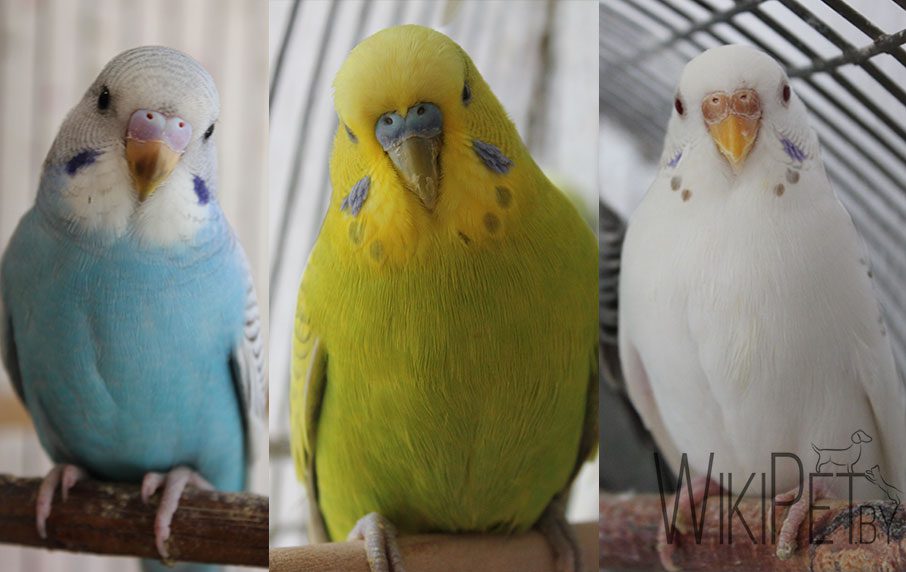
The age of most colors of budgerigars is determined by the color of the wax, the iris in the eyes and the presence of a wavy pattern on the forehead. Since the first molt in these parrots begins at the age of 4 – 5 months, then these metamorphoses occur. By the year, the bird acquires adult plumage and it is no longer possible to determine the age by external signs. However, if the bird is ringed with a non-removable ring, the year of birth is usually indicated on it.
CHARACTER AND TEMPERAMENT
Budgerigars are quite noisy birds, they constantly jump, chirp and react violently to everything, so before purchasing, think about whether you really want to share housing with such a pet. In addition, they can scatter debris around the cage, damage the wallpaper, or stain the table.
Budgerigars in nature live in flocks, so they suffer a lot without communication. You will need to constantly communicate with your pet, play and talk. If you are very busy, but at the same time feel an irresistible desire to acquire such a bird, get at least two parrots. It can be two males or a female and a male. As for the two females, they rarely get along with each other, as they constantly divide the territory. However, if there is enough space and birds are taken, for example, from one nest, then two female sisters can get along well.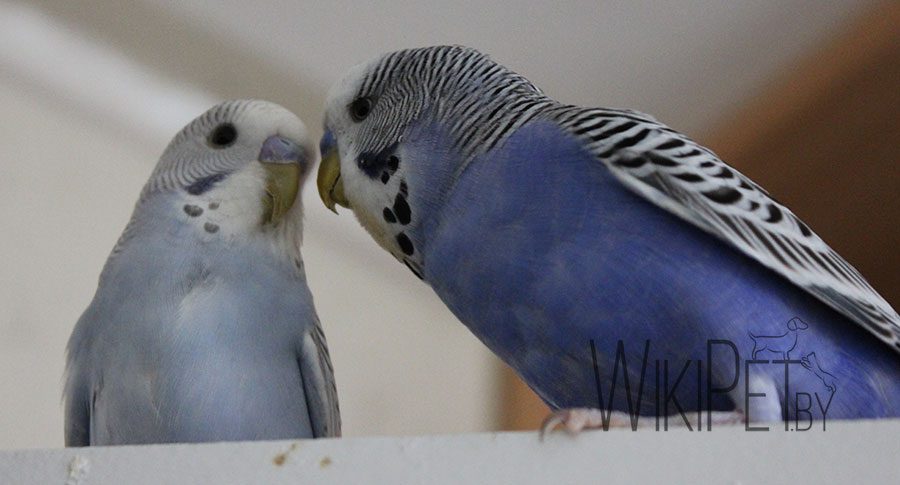
If you want a sociable pet, slowly move your hand to the cage when choosing. If a parrot panics, it is unlikely to suit you. Take the one who watches you with curiosity, runs back and forth – such a parrot is better tamed and trained. For taming, you need to choose a young bird at the age of 2 – 2,5 months.
Budgerigars are very active and must be able to fly. They must be released for at least 1 hour 3 times a week. Budgerigars are inquisitive, love to explore new places, so the room must be safe.
These birds sleep 12 – 14 hours a day, and during this time it is necessary to ensure peace and quiet.
CONTENT OF BUDGETTS
Budgerigars are quite unpretentious, but this does not mean that they do not need to be taken care of at all.
It is better to place the cage in a bright place (but not under the influence of direct sunlight), preferably against a wall, approximately at eye level, away from drafts and heaters. An unsuccessful choice would be the kitchen or the surface of the refrigerator, TV or washing machine. It is best to place a feathered friend in the living room or bedroom.
The best cage shape is rectangular, with a flat or domed top.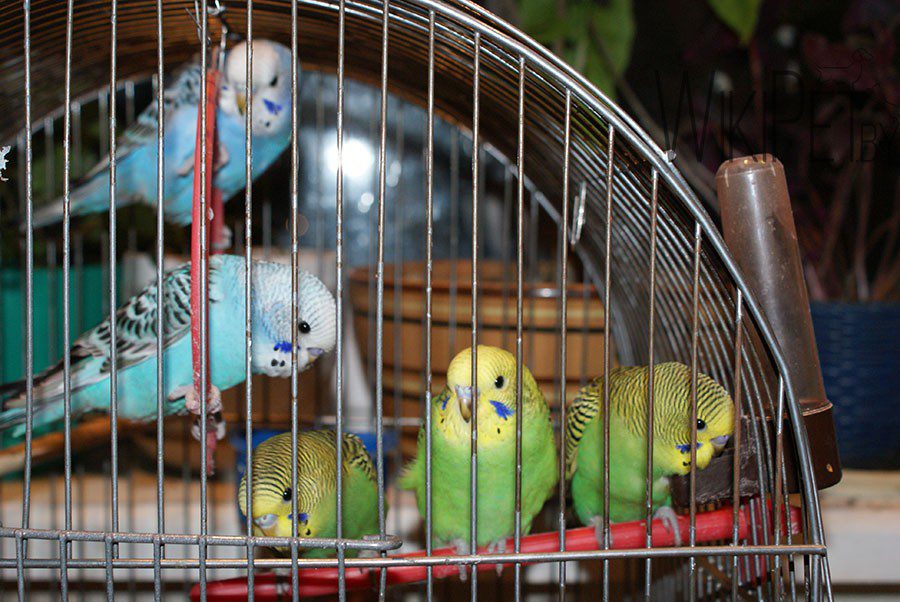
The budgerigar needs a place to rest and hide. Therefore, part of the cage should be covered with matter.
For 1 bird: length – 40 cm, width – 25 cm, height – 30 cm.
For a couple of birds: length – 60 cm, width – 30 cm, height – 40 cm.
But the bigger the cage, the better. It is better to provide a retractable bottom, hanging drinkers and retractable or hanging feeders.
It is desirable that the rods are horizontal – so the parrot can practice vertical climbing. The distance between the bars should not exceed 1 cm.
Cell disinfection is carried out at least once a month. At the time of processing the “home” birds are transplanted into another cage. Thoroughly rinse off all disinfectant, otherwise the pet may be poisoned.
Most parrots love to swim, so you need to put a bathing suit in the cage. Otherwise, the bird will bathe in the drinker, polluting the water. Water (1 – 2 cm) at room temperature is poured into the bathing suit and hung to the open door of the cage.
Paper, wood pellets or sand are placed at the bottom of the cage. But newspapers or magazines will not work: printing ink is poisonous to birds. Paper is better for controlling droppings, since it is difficult to see anything in other fillers. However, since budgerigars are “gnawing”, any filler will be chewed and tried.
The drinker and feeder are washed daily with a brush, litter is removed from the perches. The litter is changed as it gets dirty, but once a week a “general cleaning” is mandatory.
Every 2-3 months the cage is disinfected.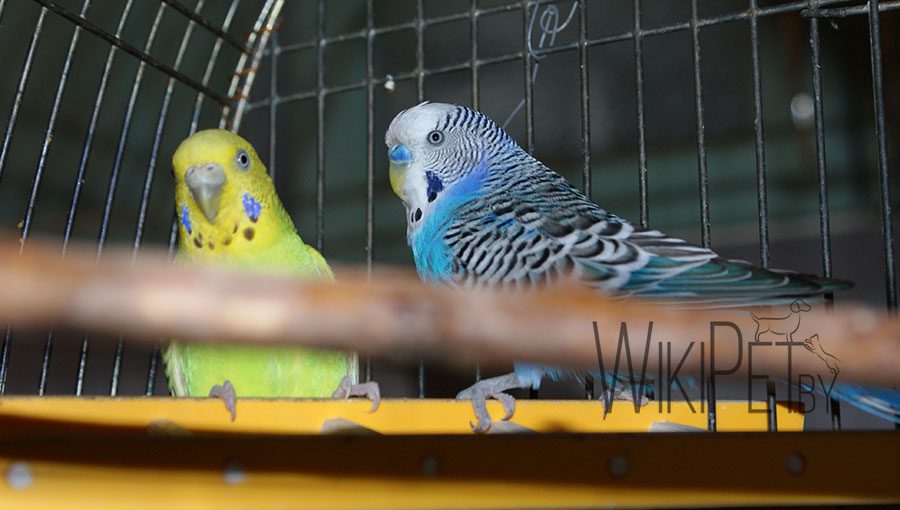
Make sure your feathered friend can fly in a safe environment. In the room, you can organize a corner for birds, where there will be a special stand with branches and toys, where the bird will spend time outside the cage. This will also solve the problem of pollution, as the litter will be collected under this stand.
Before getting a budgerigar, make sure you’re not allergic to bird powder, which budgerigars fly off in large numbers during their moult, and fluff.
FEEDING BUDGETTS
For a budgerigar, proper feeding is important. The diet consists of seeds, leaves, vegetables, fruits, herbs and young shoots of trees.
Cereal mixtures for parrots are sold at pet stores. Most often they contain canary seed (40%), oats (20%), millet (20%) and French millet (20%).
The grain mixture must be clean, free of impurities and musty smell.
However, only a grain mixture is completely insufficient for a parrot.
An important addition to the grain mixture is green fodder. It can be the tops of vegetables, tree branches and herbaceous plants (melissa pharmacy, dandelion leaves, plantain, shepherd’s purse).
Be sure to add fruits, berries (apricots, pineapples, oranges, watermelons, bananas, grapes, grapefruit, pears, blackberries, strawberries, kiwi, gooseberries, raspberries, tangerines, papaya, peaches, plums, black currants, feijoa, apples) to the diet, and vegetables (broccoli, kohlrabi, carrots, cucumber, tomatoes, lettuce, spinach, sweet and hot peppers), as well as sprouted cereals and cereals.
Be careful with animal foods (egg) as they can induce sexual behavior, especially in females. As well as overweight and excessive load on the liver. These feeds are recommended to be given only during the breeding season.
You can also, if necessary, use synthetic vitamins.
The cage must contain a mineral mixture, chalk and sepia (cuttlefish shell).
The new food is given in small quantities, and gradually its volume in the diet is increased.
Parrots are not given food from your table, they are not fed from the mouth, as human saliva can be dangerous for birds. Salt, sugar, chocolate, herbs, potatoes, eggplants, avocados and persimmons are harmful to birds. It is better not to give the parrot those products whose usefulness you are not sure. Budgerigars have a low weight and a fast metabolism, so even small doses of harmful products can adversely affect the internal organs of the bird.
BREEDING IN CAPTIVE
Budgerigars breed well in captivity. As a rule, both males and females are rather unpretentious in matters of choosing a partner.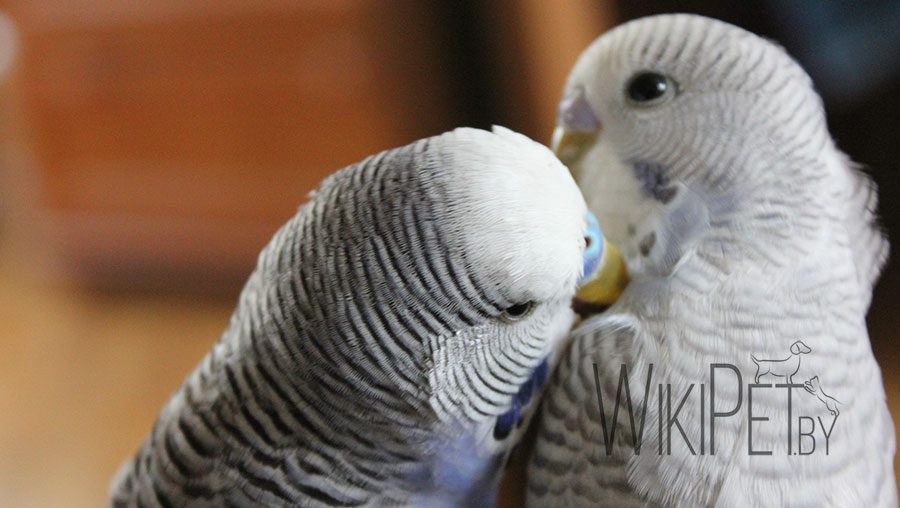
The best time for breeding is autumn and spring, when green fodder is available. However, under the right conditions, birds can breed all year round.
In order for the breeding to be successful, the birds must be properly prepared 2 weeks before hanging the house. This is an increase in daylight hours and proper nutrition.
The age of future parents should be from 1 to 5 years. Birds must be absolutely healthy and molted and in the best possible condition. Male and female should not be related.
In clutch, as a rule, 5 – 6 white eggs (sometimes up to 12). Incubation period – 17 – 18 days. The male feeds the female.
The chicks hatch completely helpless, naked and blind. A week later, fluff appears, in 10 days the eyes open. Approximately on the 25th day, the younger generation begins to look out of the notch, and at the age of 30 days it leaves the nest.
Be sure to check periodically for dead chicks in the nest.
In a year, a couple can give 2 broods of chicks, no more, since the birds need rest. You can allow 2 broods in a row, but after that the birds must rest for at least a year. Or allow birds to breed once every six months.
DELIVERY
Budgerigars are one of the most social and easily tamed birds. With the right approach, after a month of communication with the owner, the bird will trust him, boldly fly on his shoulder and even repeat a few words.
Contrary to popular belief, both females and males have the ability to tame and imitate speech. However, since budgerigars are matriarchy, females are more characteristic and aggressive. But sometimes they “speak” even better than males. The ability to imitate also depends on the abilities of the bird itself. Some parrots are able to repeat only a couple of words, while others remember more than 100. Hand parrots perceive a person as their partner and suffer greatly when their owner pays less attention to them. Sometimes, when deciding to get a friend for a pet parrot, it ends up with the fact that the birds do not get along or the pet simply ignores other birds. Therefore, when taming, remember that you are the only partner and friend of your feathered pet. Give him enough time and attention.
On the features of breeding, read the article of our expert “How to properly breed budgerigars.”



